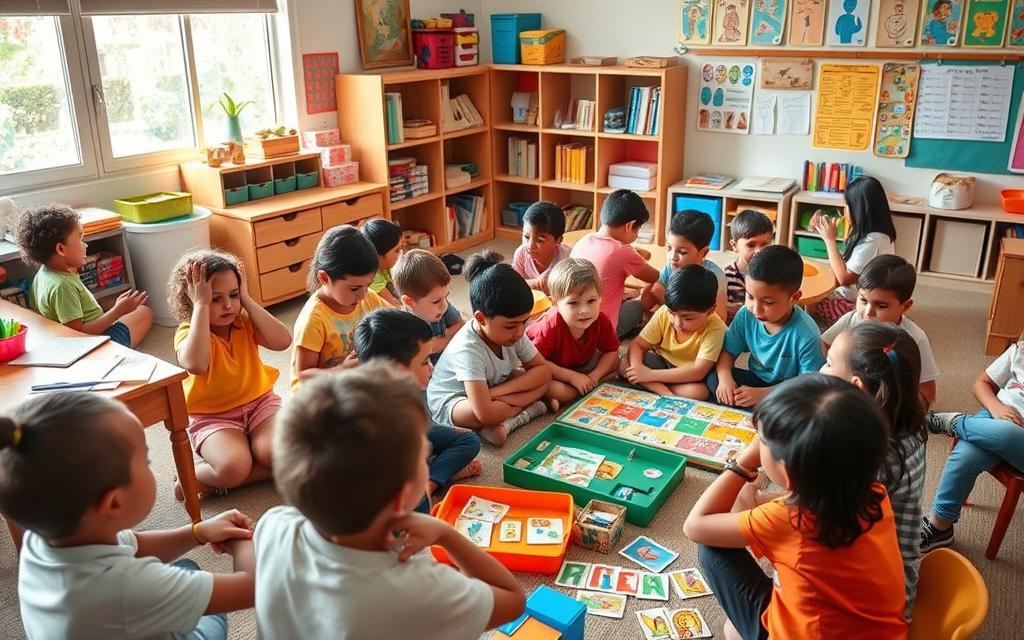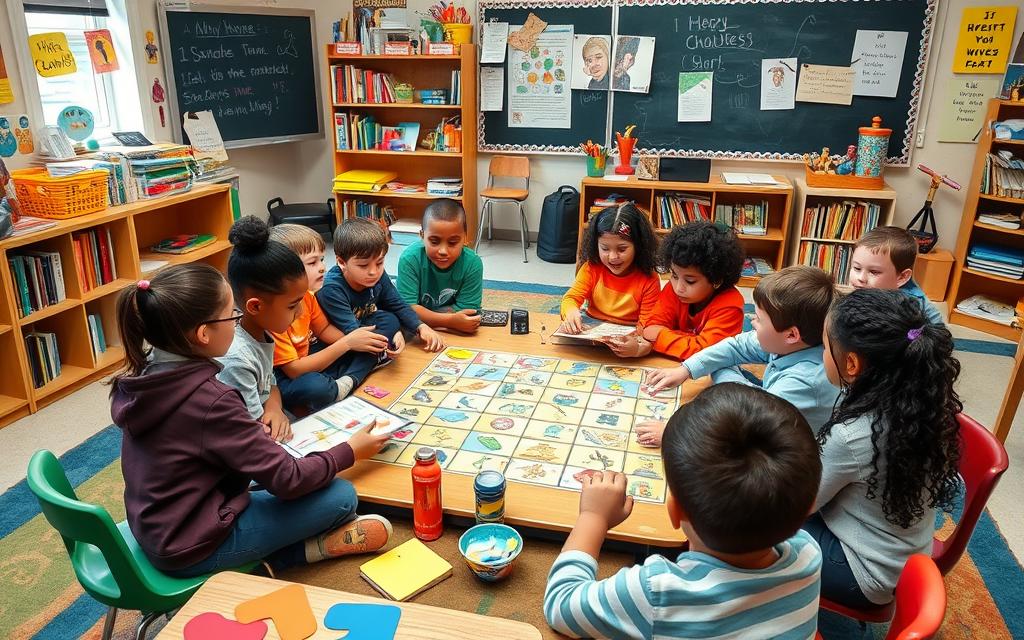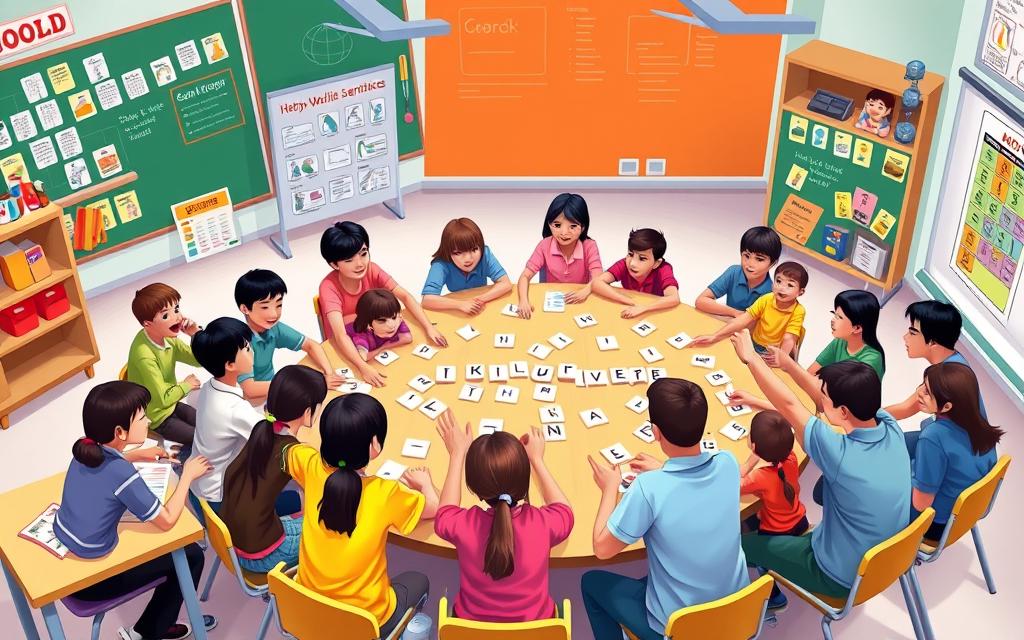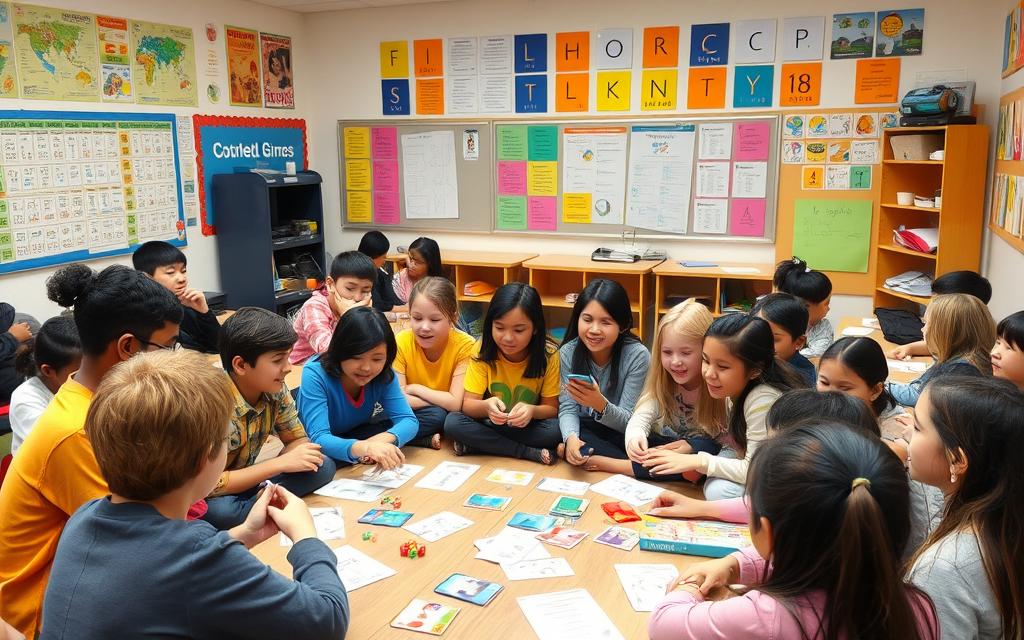Did you know students who play educational games remember language skills 30% better than those who don’t? This shows how important interactive learning activities are. As a teacher, you know screen-free ESL games are great for learning without tech. Too much screen time can hurt learning, but these games make learning English fun and engaging.
Adding screen-free ESL games to your lessons makes learning more fun and effective. These games help students focus better, think more creatively, and get involved more. Even though online games are popular, screen-free games offer a special chance for a more personal and interactive learning experience.
When you think about using screen-free ESL games, remember the benefits of interactive learning. These games can make your classroom more lively and engaging. This way, you can meet your students’ needs better.
Why Screen-free ESL Games Matter in Modern Education
When choosing the best ways for students to learn English, think about screen-free ESL games. These games let students dive into learning in a fun, hands-on way. They help students learn English better and also keep a healthy balance between screen time and other activities.
Too much screen time can hurt learning, causing less focus and slower brain growth. But, games without screens help a lot. They boost social skills, creativity, and help students remember what they learn. This makes students ready for the fast-changing world we live in.
Screen-free ESL games improve how students talk, get involved in class, and remember what they learn. They make learning fun and interactive, meeting the needs of all students. If you want to make your lessons more engaging or find new ways to teach, try these games.
Essential Materials for Your Screen-free ESL Games Collection
Building a screen-free ESL games collection is key. You need the right materials to keep your students engaged. Start by collecting a variety of offline language games for different learning styles and levels.
For screen-free learning for kids, consider board games, puzzles, and reading materials. You can also make your own games with everyday items like flashcards or word searches. The goal is to make learning fun and interactive, without screens.
Here are some essential materials to get you started:
- Board games that focus on vocabulary building and grammar practice
- Puzzles and brain teasers that promote critical thinking and problem-solving
- Reading materials, such as books and articles, that cater to different reading levels
By using these materials, you can create a fun and engaging learning experience. Keep it interactive and don’t hesitate to come up with your own games and activities.

Movement-Based Language Learning Activities
As an English learner, you can benefit from educational games for English learners that include movement. These games keep you engaged and motivated. This leads to better retention of information and improved language skills.
Studies show that creative classroom games boost learning, especially with movement. For instance, “Simon Says” and “Charades” help practice vocabulary and grammar. Plus, they make learning fun and active.
Using movement in language learning enhances engagement, retention, and comprehension, especially for young learners and kinesthetic learners. Movement-based activities make learning dynamic, fun, and interactive, reinforcing vocabulary, grammar, and communication skills through physical action. Here are some of the best ways to incorporate movement into language learning:
1. Total Physical Response (TPR)
Developed by Dr. James Asher, TPR is a method where learners respond to commands with physical actions, reinforcing meaning through movement.
- Action Verbs Game: The teacher calls out verbs (“jump,” “run,” “dance”), and students perform the action.
- Simon Says: Classic game reinforcing listening skills, grammar structures, and vocabulary.
- Follow the Leader: Students follow a leader’s actions while repeating sentences (“I am touching my nose”).
- Charades: Act out words while others guess, helping with verb recognition and comprehension.
2. Scavenger Hunts & Object Interaction
Searching for objects while using language skills encourages physical movement and reinforces vocabulary.
- Color or Shape Hunt: “Find something blue and bring it here.”
- Word Match Hunt: Hide vocabulary cards around the room, and students must find and match them with pictures or definitions.
- Preposition Practice: Students place objects based on commands (“Put the book under the chair”).
- Listening & Running: Call out words, and students run to touch or retrieve corresponding items.
3. Games & Sports-Based Language Learning
Integrating movement into competitive activities enhances motivation and engagement.
- Vocabulary Relay Races: Teams run to a board to write or match words and definitions.
- Grammar Basketball: Answer a question, then shoot a ball into a basket for extra points.
- Hopscotch Spelling: Write letters in hopscotch squares; students hop while spelling words aloud.
- Freeze Dance Storytelling: Play music; when it stops, the frozen student must add a sentence to a story.
4. Role-Playing & Drama Activities
Dramatizing scenarios helps learners internalize language through real-life communication.
- Situational Role-Plays: Assign roles (restaurant, doctor’s office, airport) and let students act out dialogues.
- Puppet Shows: Great for younger learners to practice dialogue, storytelling, and pronunciation.
- Emotion Walks: Call out emotions (happy, angry, scared), and students walk across the room embodying that emotion while saying related phrases.
- Guess the Character: Act out a famous character or animal while others guess using descriptive language.
5. Dance & Music for Language Learning
Songs and movement combined make learning rhythmical and memorable.
- Action Songs: “Head, Shoulders, Knees, and Toes” or “If You’re Happy and You Know It” help with body parts and actions.
- Choreographed Vocabulary Dance: Assign movements to words in a song to reinforce meanings.
- Circle Dance Vocabulary: Students form a circle, dance, and swap places when hearing certain words.
- Rhythm-Based Sentence Building: Students clap and step in rhythm while constructing sentences.
6. Interactive Storytelling with Movement
Stories that incorporate physical movement boost comprehension and engagement.
- Story Walks: Move to different stations where parts of the story unfold with actions.
- Act-It-Out Stories: Assign students different characters and let them act while the story is read.
- Gesture-Based Storytelling: Each word or phrase has a specific gesture, reinforcing meaning.
- Make-Your-Own Adventure: Students physically move to different parts of the room to choose how a story progresses.
7. Outdoor & Nature-Based Learning
Outdoor activities provide a refreshing environment for language learning.
- Nature Walk Vocabulary: Students collect items and describe them using new words.
- Treasure Hunts: Hide clues in the target language, guiding students to a final prize.
- Field Trip Journals: Visit a park or zoo and describe experiences using learned vocabulary.
- Running Dictation: One student runs to a posted sentence, memorizes it, and reports back to a partner who writes it down.
8. Interactive Classroom Setups
Making the classroom physically interactive keeps learners engaged.
- Word Wall Walk: Students walk to different words and form sentences with them.
- Human Sentence Formation: Each student holds a word, and they arrange themselves into correct sentences.
- Four Corners: Label corners with different answer choices; students move to the correct one when a question is asked.
- Standing Polls: Instead of raising hands, students move to different areas to indicate their answers.
Why Movement-Based Learning Works
✔ Enhances memory retention – Physical activity reinforces neural connections.
✔ Increases engagement – Learners are more focused when actively involved.
✔ Encourages social interaction – Many activities require teamwork and communication.
✔ Cater to different learning styles – Particularly beneficial for kinesthetic and auditory learners.
✔ Reduces anxiety – Moving while learning feels more natural than sitting for long periods.
Movement-based language learning transforms a traditional classroom into an interactive, engaging space where students absorb language naturally. By incorporating physical activities, storytelling, role-playing, and games, educators can make grammar, vocabulary, and communication more dynamic and effective.
Adding movement-based activities to your study routine makes learning English fun and effective. So, why not try it and see the difference for yourself?

Creative Writing and Storytelling Games
Explore interactive language activities by adding creative writing to your ESL games. This method helps students write outside of school, making it fun and engaging. Use prompts that spark creativity and original content.
For engaging language games, try storytelling sessions or writing prompts about pictures or objects. These activities boost writing and storytelling skills. They also encourage critical thinking and creativity. By using screen-free ESL games, you make learning more interactive and fun for all.
- Word association games, where students write a story or poem based on a given word or phrase
- Picture description challenges, where students write a descriptive paragraph about a given image
- Storytelling sessions, where students take turns adding to a story or creating their own narrative
Adding these interactive language activities to your lessons helps students improve their writing and storytelling. It also boosts critical thinking and creativity. Make sure your activities are screen-free and focus on engaging language games that encourage student participation.
Speaking-Focused Screen-free ESL Games
Exploring hands-on ESL learning shows the importance of interactive teaching tools. Offline language games, like board game nights, are great for improving speaking skills. They also help students get to know each other better.
These games can be changed to suit different levels and topics. For instance, conversation card activities help practice specific grammar and real-life language use. Role-playing exercises make learning to speak more fun and interactive.

Some examples of these games include discussion-based ones. Students talk in pairs or small groups about various topics. These games can be adjusted for different levels and interests. They make learning more fun and effective.
Some benefits of these games include:
- Improved speaking skills through interactive and immersive activities
- Enhanced vocabulary practice through targeted grammar structures and realistic language use
- Increased student engagement and motivation through hands-on ESL learning
Using speaking-focused screen-free ESL games in your teaching can make learning more engaging. These games work well with other interactive tools to create a great language program.
Vocabulary Building Through Hands-on Activities
Looking for ways to boost your students’ vocabulary? Try screen-free learning for kids. Creative classroom games and educational games for English learners are great. Word association games, for example, can be played in groups or as a whole class.
Memory-based learning, like matching games or memory cards, is also effective. Picture description challenges help students improve their language skills. These activities work for different ages and language levels, making them useful for teachers.

- Word association games, where students take turns saying a word related to the previous word
- Memory-based learning activities, such as matching games or memory cards
- Picture description challenges, where students describe a picture using vocabulary words
Use these activities with other teaching methods for a well-rounded language learning experience.
Grammar Practice Without Worksheets
Interactive language activities can change the game for learning. Engaging language games, especially those that focus on grammar, help students grasp the subject better. In fact, 80% of educators say hands-on grammar games boost student engagement and understanding.
Screen-free ESL games let students practice grammar without worksheets. These games can be team-based, encouraging students to work together. For instance, you can design a game where teams tackle grammar challenges. This way, students learn grammar while improving teamwork and communication.
Here are some interactive language activities for grammar practice:
- Grammar charades: Students act out grammar concepts, like verb tenses or sentence structures, for their classmates to guess.
- Grammar bingo: Students play bingo, marking grammar concepts on their cards.
- Grammar scavenger hunt: Students search the classroom or school for examples of grammar in use.

Role-Playing and Simulations
- Why it works: Role-playing allows students to practice grammar in authentic scenarios, making it more relatable and memorable.
- Examples:
- Dialogue Creation: Assign pairs of students to write and perform dialogues using specific grammar rules, such as conditional sentences or reported speech.
- Real-Life Scenarios: Set up mock situations like ordering food at a restaurant or interviewing for a job, requiring correct grammar usage.
- Character Narration: Have students narrate stories from the perspective of characters, focusing on consistent verb tenses or pronoun use.
Hands-On Manipulatives
- Why it works: Physical objects help students visualize abstract grammar concepts and engage kinesthetically.
- Examples:
- Sentence Strips: Cut sentences into individual words or phrases and have students rearrange them into grammatically correct orders.
- Color-Coded Blocks: Use blocks of different colors to represent subjects, verbs, objects, and modifiers, allowing students to build sentences visually.
- Magnetic Words: Place magnetic words on a board for students to construct and revise sentences collaboratively.
Interactive Discussions and Debates
- Why it works: Verbal interaction reinforces grammar skills by encouraging students to articulate their thoughts clearly and accurately.
- Examples:
- Classroom Debates: Assign topics and require students to use formal grammar, such as complex sentences or conjunctions, during debates.
- Think-Pair-Share: Pose a grammar-related question, let students discuss it in pairs, and then share their insights with the class.
- Error Analysis: Present sentences with intentional errors and ask students to identify and correct them during group discussions.
Songs, Rhymes, and Chants
- Why it works: Music and rhythm enhance memory retention and make grammar rules easier to recall.
- Examples:
- Grammar Songs: Teach songs that explain rules for plurals, verb conjugations, or punctuation marks.
- Rap Battles: Encourage students to create raps using specific grammar structures, such as prepositions or conjunctions.
- Chanting Exercises: Repeat chants like “I before E except after C” to reinforce spelling and grammar conventions.
These engaging language games build a strong grammar foundation. They make learning fun and interactive. With the right approach, you can create a lively learning space that meets your students’ needs.
Team-Building Language Games for Group Settings
Interactive ESL teaching resources are key for engaging learning. Team-building language games are a great way to make lessons fun and effective. They help students learn by working together and having fun.
Games like “Common Thread,” “Fingertip Hula-Hoop,” and “Four-Way Tug-of-War” are perfect for groups. They boost teamwork and communication. Plus, they’re great for classrooms without much tech or for a break from screens.
“Hot Seat” and “Classification” games also make learning fun. They challenge students to think and solve problems together. These games improve teamwork, problem-solving, and communication while teaching ESL.

- Improved communication and teamwork skills
- Enhanced problem-solving and critical thinking skills
- Increased student engagement and participation
- Development of hands-on ESL learning skills
Interactive ESL resources and offline games make learning exciting. They create a dynamic and effective learning space for all students.
Adapt Traditional Games for ESL Learning
Think about making learning fun by adapting traditional games for ESL. This method can lead to creative classroom games that are both fun and effective. It also helps improve retention rates through educational games for English learners.
About 70% of ESL learners find games helpful for learning. Games like Scrabble and Boggle can be made into screen-free ESL games. These games boost spelling and vocabulary, with up to 90% retention when played regularly.
Adapting traditional games for English as a Second Language (ESL) learning is an innovative and effective way to engage students while teaching language skills. Traditional games, often rooted in cultural or recreational contexts, can be modified to focus on vocabulary, grammar, pronunciation, listening, speaking, reading, and writing. This approach not only makes learning enjoyable but also provides a low-pressure environment where students feel motivated to practice English. Below are some examples of how traditional games can be adapted for ESL learning, along with their benefits and implementation strategies.
1. Charades
- Original Game: Players act out words or phrases without speaking, and others guess what they are.
- ESL Adaptation:
- Focus on vocabulary related to specific topics (e.g., animals, emotions, actions).
- Require students to use full sentences when guessing (“You are pretending to swim”).
- Benefits:
- Encourages non-verbal communication and contextual understanding.
- Builds confidence in using target vocabulary.
- Implementation:
- Write vocabulary words on slips of paper and have students draw them randomly.
- Divide the class into teams and award points for correct guesses.
2. Bingo
- Original Game: Players mark off numbers or items on a grid as they are called out.
- ESL Adaptation:
- Replace numbers with words, pictures, or phrases (e.g., irregular verbs, prepositions, or sight words).
- Call out definitions, synonyms, or sentences containing the target word instead of the word itself.
- Benefits:
- Reinforces recognition of key vocabulary and grammar structures.
- Provides repetition in a fun and competitive format.
- Implementation:
- Create custom bingo cards tailored to the lesson’s focus (e.g., past tense verbs).
- Use visual aids or audio clips to call out clues.

3. Hangman
- Original Game: Players guess letters to complete a hidden word before a stick figure is “hanged.”
- ESL Adaptation:
- Use thematic words (e.g., food, weather) or grammar-focused terms (e.g., parts of speech).
- Incorporate sentence-level challenges by having students guess entire sentences or phrases.
- Benefits:
- Enhances spelling and letter recognition.
- Encourages strategic thinking about word patterns.
- Implementation:
- Allow students to take turns choosing the word or phrase.
- Provide hints or categories to scaffold learning for beginners.
4. Simon Says
- Original Game: Players follow commands only if prefaced with “Simon says.”
- ESL Adaptation:
- Use action verbs and prepositions (e.g., “Simon says touch your head” or “Simon says stand behind the chair”).
- Introduce more complex instructions as students progress (e.g., “Simon says clap three times”).
- Benefits:
- Develops listening comprehension and physical response to language.
- Reinforces imperative sentences and verb usage.
- Implementation:
- Start with simple commands and gradually increase difficulty.
- Encourage students to take turns being “Simon.”
5. Scavenger Hunt
- Original Game: Players search for hidden items based on clues.
- ESL Adaptation:
- Hide objects around the classroom or provide riddles that describe vocabulary words.
- Include written or spoken clues that require students to decode meaning.
- Benefits:
- Promotes teamwork and problem-solving while practicing reading and listening skills.
- Reinforces descriptive language and context clues.
- Implementation:
- Pair students to work together and communicate in English.
- Use themes like colors, shapes, or household items to align with lesson objectives.
6. Pictionary
- Original Game: Players draw pictures to represent words or phrases, and others guess what they are.
- ESL Adaptation:
- Focus on vocabulary sets (e.g., jobs, hobbies, travel) or grammar concepts (e.g., present continuous tense).
- Encourage students to describe their drawings verbally after guessing.
- Benefits:
- Strengthens vocabulary recall and creativity.
- Supports visual and verbal learning styles.
- Implementation:
- Use whiteboards or paper for drawing.
- Limit time per round to keep the game fast-paced and engaging.
7. Memory Match
- Original Game: Players flip over cards to find matching pairs.
- ESL Adaptation:
- Match words with their definitions, synonyms, antonyms, or corresponding images.
- Match subject-verb pairs or sentence halves to reinforce grammar rules.
- Benefits:
- Improves memory retention and association skills.
- Reinforces connections between words and meanings.
- Implementation:
- Create custom card sets based on current lessons.
- Play in small groups to encourage peer interaction.
8. Jeopardy
- Original Game: Players answer questions across various categories to earn points.
- ESL Adaptation:
- Categories can include grammar (e.g., tenses, prepositions), vocabulary (e.g., food, clothing), or pronunciation (e.g., minimal pairs).
- Questions can range from multiple-choice to open-ended responses.
- Benefits:
- Covers a wide range of language skills in one activity.
- Fosters healthy competition and active participation.
- Implementation:
- Use digital templates (e.g., PowerPoint or online platforms) to create interactive boards.
- Divide students into teams and rotate answering turns.
9. Twenty Questions
- Original Game: One player thinks of an object, and others ask up to 20 yes/no questions to guess it.
- ESL Adaptation:
- Restrict topics to specific vocabulary sets (e.g., animals, countries, professions).
- Require students to formulate grammatically correct questions (e.g., “Is it bigger than a cat?”).
- Benefits:
- Develops question formation and critical thinking.
- Encourages deductive reasoning and conversational practice.
- Implementation:
- Model example questions before starting the game.
- Provide scaffolding for lower-level learners with question starters.
10. Board Games
- Original Games: Examples include Snakes and Ladders, Monopoly, or Scrabble.
- ESL Adaptation:
- Add language tasks to each turn (e.g., define a word, conjugate a verb, or use a vocabulary term in a sentence).
- Modify Scrabble to focus on spelling high-frequency words or phrasal verbs.
- Benefits:
- Combines strategy and language practice in a familiar format.
- Encourages sustained engagement through gameplay.
- Implementation:
- Create custom boards or adapt existing ones with ESL-specific challenges.
- Use dice rolls or spinners to determine tasks.
Adding these games to your lessons makes learning more engaging and interactive. Make sure to keep games screen-free for a more immersive learning experience.
Assessment and Progress Tracking in Screen-free Activities
When you use interactive ESL teaching resources and offline language games, it’s key to track how students are doing. You can do this by watching how they do in these activities. This way, you can see how well they understand the language and where they might need more help.
It’s also important to make rubrics for assessing students. These rubrics should cover different areas like speaking, listening, vocabulary, and grammar. This helps you make sure your evaluations are thorough and give you useful information to improve your teaching.
Measure Student Engagement
To see how engaged students are, you can use quizzes, games, and class talks. For example, you can make a quiz with Quizlet or Kahoot! to check if they get vocabulary or grammar. Or, you can use tools like Boom Cards or Nearpod for interactive lessons that show how students are doing. This makes learning fun and keeps students interested and motivated.

By adding these ways to check on students to your screen-free ESL activities, you can make a great language learning program. Use lots of different interactive ESL teaching resources and offline language games to keep students excited and motivated. Also, always check and track their progress to help you teach better.
Troubleshoot Common Challenges in Screen-free ESL Games
When you start using screen-free ESL games, you might face some hurdles. One big issue is engaging students who love screen time. To solve this, add interactive language activities that get them moving and involved.
Another problem is managing classroom dynamics. To fix this, pick engaging language games that boost teamwork. For instance, a scavenger hunt can make students team up to find and name vocabulary words.
Here are some tips to tackle common problems in screen-free ESL games:
* Choose screen-free ESL games that match your students’ likes and skill levels
* Add interactive language activities that challenge their thinking and problem-solving skills
* Make sure to include engaging language games that encourage creativity and self-expression
By using these strategies and being adaptable, you can beat common challenges. This way, you’ll make your screen-free ESL game a hit with your students.
Implement Screen-free ESL Games Successfully
Exploring hands-on ESL learning and interactive ESL teaching resources can change the game for your students. By using offline language games, you create a lively, engaging space. This space helps students develop key communication skills.
To succeed with screen-free ESL games, find a balance. Mix these activities with your digital tools. This way, students get the best of both. With good planning and a spirit of trying new things, you can make screen-free learning work. It will help your students do well in their language learning.
Key Takeaways
- Screen-free ESL games can enhance learning without relying on technology
- Interactive language activities can improve focus and increase creativity
- Educational games for English learners can boost student participation and engagement
- Screen-free games can help reduce excessive screen time and its negative impacts on learning
- Incorporating screen-free ESL games can create a more personalized and interactive learning experience
- Screen-free ESL games can be adapted to meet the needs of different learners and learning styles
Source Links
- Games for Learning English, Vocabulary, Grammar Games, Activities, ESL – https://www.eslgamesplus.com/
- ESL Games and Activities for Kids & Teens – https://bridge.edu/tefl/blog/esl-games-activities-kids-young-learners/
- The Power of Play: How Fun and Games Help Children Thrive – https://www.healthychildren.org/English/family-life/power-of-play/Pages/the-power-of-play-how-fun-and-games-help-children-thrive.aspx
- No title found – https://www.prodigygame.com/main-en/blog/game-based-learning/
- Exploring the Benefits of Video Games in Education – https://blog.acceleratelearning.com/exploring-the-benefits-of-video-games-in-education
- ESL Games and Resources — Teach English in Thailand with Kids English – https://kidsenglishthailand.org/blog/online-resources-and-esl-games
- ESL Internet Resources – MNA Resources – https://resources.pcamna.org/resource/esl-internet-resources/
- ESL Teaching Materials – Kid-Inspired Classroom – https://kid-inspired.com/category/esl-teaching-materials/
- 16 Language Learning Games & Activities: Fun & Effective – https://preply.com/en/blog/at-home-language-learning-games/
- 12 Activities That Use Movement to Motivate your Spanish Class Students • The Engaged Spanish Classroom – https://theengagedspanishclassroom.com/2018/11/motivation-through-movement-in-a-world-language-classroom.html
- Top 20 Language Games and Activities for Fun – https://www.marstranslation.com/blog/top-20-language-games-and-activities-for-fun
- Online ESL Games – ESL Kids Games – https://www.eslkidsgames.com/online-esl-games
- ESL Games for Teaching Online – https://bridge.edu/tefl/blog/esl-games-teaching-online/
- ESL Board Games Interactive – ESL Kids Games – https://www.eslkidsgames.com/esl-board-games-interactive
- Modal Verbs of Possibility and Certainty – https://www.teach-this.com/parts-of-speech-activities-worksheets/modal-verbs-possibility-certainty
- 8 Exciting ESL Vocabulary Games for Teaching In Person or Online – https://bridge.edu/tefl/blog/esl-vocabulary-games/
- 10 Fun ESL Games and Activities for Teaching Kids English Abroad – https://www.gooverseas.com/blog/10-best-games-esl-teachers
- 30 Hands-On Grammar Games That Make Learning Fun – https://www.weareteachers.com/grammar-games/
- 67 Free ESL Games To Teach English Like An All-Star – ALL ESL – https://allesl.com/free-esl-games/
- 43 Awesome Team-Building Games and Activities for Kids – https://www.weareteachers.com/team-building-games-and-activities/
- 45 Team Building Games to Psych Up Your Team [2024] • Asana – https://asana.com/resources/team-building-games
- 35 Engaging ESL Games to Enhance Your English | Scribendi – https://www.scribendi.com/academy/articles/esl_games_to_enhance_your_english.en.html
- Last-Minute ESL Lesson Plans That Can Be Adapted for Any Class – https://bridge.edu/tefl/blog/last-minute-esl-lesson-plans/
- Spice Up the Learning: ESL Classroom Games That Make English Fun! – https://teacherspitstop.com/10-esl-games-for-large-classrooms/
- ESL Assessment and Guide for ESL Teachers | Kid-Inspired Classroom – https://kid-inspired.com/english-language-assessment/
- 11 best free teaching tools for teachers | Teach Away – https://www.teachaway.com/blog/11-free-teaching-tools-online-teachers
- Screen-Free Computational Thinking – https://www.edutopia.org/article/screen-free-computational-thinking/
- Screen time for kids: advice & alternatives | Parents | Nat Geo Kids – https://www.natgeokids.com/uk/parents/screen-time-for-kids/
- Tips for setting screen time limits as a parent – https://www.mayoclinic.org/healthy-lifestyle/childrens-health/in-depth/screen-time/art-20047952
- Digital Detox: Why and How to Implement Screen-Free Days – https://www.jetlearn.com/blog/how-to-implement-screen-free-days
- Embracing Screen-Free Week: Strategies for Schools to Enhance Engagement and Learning | EuHu – https://www.euhu.co.uk/articles/embracing-screen-free-week



